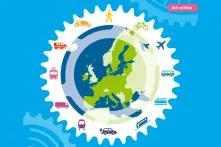
The ‘last mile’ is often a key problem in public transport. Smartly planned intermodal intersections and digitalisation offer a range of possibilities to close that gap in the transportation chain—even with solutions for an individual mobility.

In the past, Public Transport Organisations (PTOs) have organised bus and regional train services. Their tasks included the configuration of attractive ticket prices and ended there. PTOs have been reasonably successful, as the numbers of passengers in public transport have been rising for years, and buses and trains have been operating at full capacity.
Nevertheless, traditional efforts to encourage people to leave their cars at home and use public transport, such as establishing bus lines and giving away free tickets, are reaching their limits and further incentives are needed. The rural population is particularly in need of solutions for their daily mobility.
The purchase of tickets is one of the key factors and the option of buying tickets online should be natural in our digital age. Tickets can be made available on smartphones and shown to the driver upon entering the vehicle. Protection against forgery has long been an issue, but has been solved by means of security features such as real digital tickets instead of ones in a file format, or QR-codes which can be read and verified by any ticket inspector.
When observing user habits, for example in Austria, a generational gap becomes apparent. Up to 71 percent of people under 24 years of age use their smartphones regularly to retrieve information about the public transport timetable, but only 21 percent of those over 55 use their phones for this purpose. While 17 percent of young people buy their tickets via an app, the 6 percent figure for people above 55 is still low.
In Austria, the national government plans to introduce a so-called 1-2-3-ticket: 1 euro per day for one state, 2 euros per day for two states and 3 euros for the whole federal territory. Some states, such as Vorarlberg and Vienna, have already introduced the 365€-Ticket (1 euro per day) and have seen a clear increase of users of public transport.
The so-called ‘last mile’ is often a problem for those who live far from city centres. How can people get home late at night when they take the last train, but there is no connecting bus service? As PTOs cannot provide buses at any time of the day and to any hamlet, other solutions have to be developed to cover the ‘last mile’.
As people have different habits, the solutions to the issue of the 'last mile' must also offer various possibilities. Small buses which run only on demand can cover longer distances. People can use car-sharing for a more individual mobility. And bike-lanes help to make it possible for people to reach public transport with their own bike.
To be able to use public transport more easily, important junctions of public transport have to be transformed into intermodal intersections. Modern intermodal intersections have different infrastructures available to change from private transport to buses and trains. Park & Ride and Bike & Ride facilities are the basic configurations. As electric bikes become more popular, more closed bike-boxes will be integrated. Infrastructure for charging electric cars and bikes should be provided. As infrastructure has a long-term planning horizon, it is crucial to develop a strategic plan for the building of intermodal intersections. The counting of passengers, passenger potential and surveying the available infrastructure and their utilisation build the basis of such strategic plans. These are set up for 10 years and closely adhered to.
In order for the intermodal intersections to function properly, collaboration with other stakeholders is a determining factor. Train companies often own property at stations, and regions and communities have to build bike lanes and paths that lead to the intersections.
Moreover, car- and bike sharing is quickly becoming an imaginable alternative for many people and is a useful supplement to public transport.
Some PTOs have already begun to present their own car-sharing options or take over the management for bundle offers of private car-sharing companies. An upgrade to an annual ticket can complete the offer of the public transport system. Areas with car-sharing vehicles and intermodal intersections follow similar selection criteria: places where many people enter the public transport system meet the requirements for a successful car-sharing station.
Car-sharing can prevent families from buying a second or third car which is not often used. One car-sharing vehicle can replace up to 20 cars and saves precious space as car parks are no longer necessary. In Austrian communities with less than 10,000 inhabitants, up to 38 percent of the households have more than one car, whereas in Vienna only 9 percent of households own more than one car.
Bike sharing can be a good addition to the public transport system in towns of all sizes where the ‘last mile’ can be powered by the traveller's own muscular strength. In many cities in Europe, those systems are already in use, but they could also be extended to private companies to help employees to use bikes more easily to get to work.
In all of these solutions, digitalisation is an important success factor. On digital platforms, customers can easily access multimodal mobility and for PTOs, the platform can make the customer handling easier.
In order for public transport to play a major part in the mobility transition, it has to be thought about beyond its boundaries. Alternative offers and multimodal concepts are not only shaping the future, but are also already a fixed element of public transport systems. In addition, the so-called ‘last mile’ causes problems which prevent people from using buses or trains instead of their own cars. This calls for more flexible and demand-driven solutions.
Sources for data and graphics: AGFS NRW, Nahmobilität 2.0 p.22, https://bit.ly/2TBKjl0; Benjamin Kühne & Michael Adler, Helsinki: Die Flatrate für alle Verkehrsmittel, https://bit.ly/3l1xgFg; Matthias Breitinger, Flatrate statt eigenes Auto, https://bit.ly/2HNq4hR

